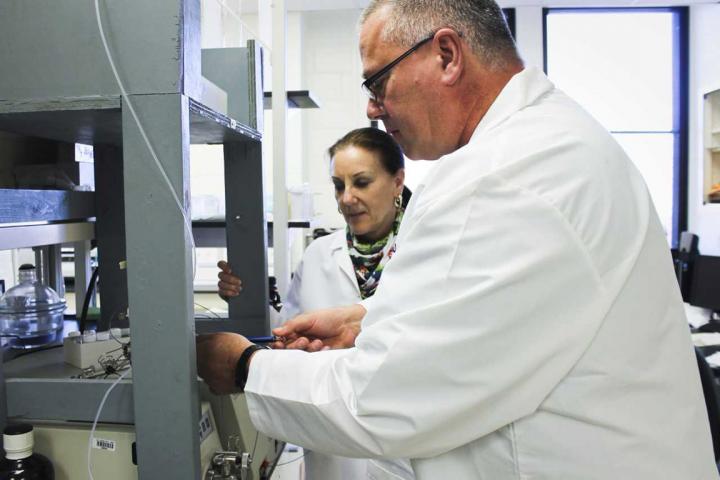In a first-of-its-kind operation in the United States, a team of doctors at Duke University Hospital helped create a bioengineered blood vessel and transplanted it into the arm of a patient with end-stage kidney disease.
The procedure, the first U.S. clinical trial to test the safety and effectiveness of the bioengineered blood vessel, is a milestone in the field of tissue engineering. The new vein is an off-the-shelf, human cell-based product with no biological properties that would cause organ rejection.
Using technology developed at Duke and at a spin-off company it started called Humacyte, the vein is engineered by cultivating donated human cells on a tubular scaffold to form a vessel. The vessel is then cleansed of the qualities that might trigger an immune response. In pre-clinical tests, the veins have performed better than other synthetic and animal-based implants.
“This is a pioneering event in medicine,” said Jeffrey H. Lawson, M.D., PhD, a vascular surgeon and vascular biologist at Duke Medicine who helped develop the technology and performed the implantation. “It’s exciting to see something you’ve worked on for so long become a reality. We talk about translational technology – developing ideas from the laboratory to clinical practice – and this only happens where there is the multi-disciplinary support and collaboration to cultivate it.”
Clinical trials to test the new veins began in Poland in December with the first human implantations. The U.S. Food and Drug Administration recently approved a phase 1 trial involving 20 kidney dialysis patients in the United States, followed by a safety review. Duke researchers enrolled the first U.S. patient and serve as study leaders.
The initial trial focuses on implanting the vessels in an easily accessible site in the arms of kidney hemodialysis patients. More than 350,000 people in the United States require hemodialysis, which often necessitates a graft to connect an artery to a vein to speed blood flow during treatments. Current options have drawbacks. Synthetic vascular grafts are prone to clotting, leading to frequent hospitalizations, and harvesting veins from the patient’s own body involves a separate procedure, with the risk of infection and other complications.
If the bioengineered veins prove beneficial for hemodialysis patients, the researchers ultimately aim to develop a readily available and durable graft for heart bypass surgeries, which are performed on nearly 400,000 people in the United States a year, and to treat blocked blood vessels in the limbs.
“We hope this sets the groundwork for how these things can be grown, how they can incorporate into the host, and how they can avoid being rejected immunologically,” Lawson said. “A blood vessel is really an organ – it’s complex tissue. We start with this, and one day we may be able to engineer a liver or a kidney or an eye.”
The bioengineered vein is the product of a 15-year collaboration between Lawson and Laura Niklason, M.D., PhD, co-founder of Humacyte and a former faculty member at Duke who is now at Yale. Lawson and Niklason teamed up in the late 1990s after discovering they shared an interest in engineering blood vessels.
Building on work Niklason began as a bioengineering post-doctoral student, the duo worked to perfect the technology in animal models and eventually moved to develop veins for human implantation.
“The bioengineered blood vessel technology is a new paradigm in tissue engineering,” said Niklason, professor and vice chair of anesthesia, professor of biomedical engineering, Yale University, and founder of Humacyte. “This technology is a key step for patients with end-stage renal disease and can potentially avoid surgical interventions and hospitalizations. The fact that these vessels contain no living cells enables simple storage onsite at hospitals, making them the first off-the-shelf engineered grafts that have transitioned into clinical evaluation.”
Overcoming setbacks and frustrations, the researchers notched numerous advancements, starting with the biodegradable mesh as the scaffolding for the veins. The mesh, easily manipulated into any shape, is formed into a blood vessel of varying lengths and widths.
When seeded with smooth muscle cells, the mesh gradually dissolves as the cells grow in a special medium of amino acids, vitamins and other nutrients. One key improvement, which strengthens the bioengineered tissue, is a pulsing force introduced during the growth process, in which the nutrients are pumped through the tube in a heartbeat rhythm to build the physical properties that are similar to native blood vessels.
After a couple of months, a life-like vein results.
Originally, the researchers sought to develop veins using a person’s own cells to seed the scaffolding, reducing the risk that the patient’s body would reject the implanted tissue. But growing personalized veins took too much time and ruled out mass production, so the researchers changed tack to develop a universal product.
Using donated human tissue to seed the tubular matrix, they wash the resulting vein in a special solution to rinse out the cellular properties, leaving a collagen structure that does not trigger an immune response.
“At the end of the process, we have a non-living, immunologically silent graft that can be stored on the shelf and used in patients whenever they need it,” Niklason said. “Unlike other synthetic replacements made of Teflon or Dacron, which tend to be stiff, our blood vessels mechanically match the arteries and veins they are being sewn to. We think this is an advantage.”
When implanted in animals, the vein grafts actually adopt the cellular properties of a blood vessel. They don’t just elude rejection; they become indistinguishable from living tissue as cells grow into the implant.
“They are functionally alive,” Lawson said. “We won’t know until we test it if it works this way in humans, but we know from the animal models that the blood travels through the blood vessels and they have the natural properties that keep the blood cells healthy.”
Story Source:
The above story is reprinted from materials provided by Duke University.





